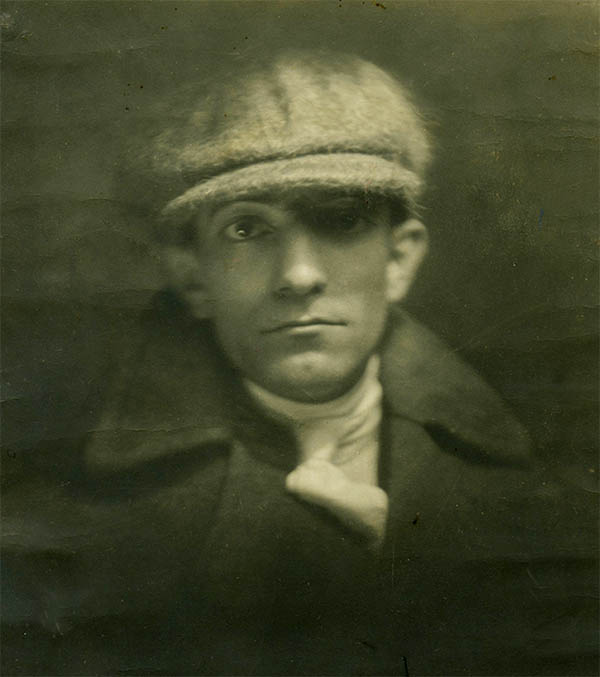
Almada and geometry
Born in São Tomé and Príncipe in 1893 to a Portuguese father and a Portuguese-Angolan mother, José Sobral de Almada Negreiros was brought up and educated in Lisbon, together with his brother António, at the Jesuítas de Campolide boarding school. After his mother’s death in 1896, his father moves to France. In 1913 Almada holds his first solo exhibition. He joins the group of Orpheu magazine, created in 1915 by Fernando Pessoa and Mário de Sá-Carneiro. He proclaims himself a futurist and writes four avant-garde manifestos, earning a reputation for making scandal in public places, on his own or together with Santa Rita Pintor. Those years are fertile in artistic collaborations, reflecting the avant-garde fervour of the 1910s, and later the 1920s’ liberation of social mores and bohemian life.
In 1919 Almada leaves for Paris, where he will live for one year. He extends the shaft of the “d” in his very recognizable signature, which he will use from then on. In the 1920s he tightened relations with several Spanish artists and intellectuals, and leaves for Madrid in 1927, where he makes a name for himself in the Madrilenian artist milieu, holding a solo exhibition, contributing to several group expositions and collaborating with musicians, writers and architects.
He returns to Portugal in 1932, where he witnesses the implementation of Estado Novo’s cultural policies, which establish a new way of working for artists. He takes on several public and private commissions, producing stained-glass pieces, tile panels, fresco paintings, among other works, mainly in collaboration with architect Porfírio Pardal Monteiro. At the same time, he maintains a steady production of drawings and paintings, graphic designs, literary texts, poems, theatre plays and conferences.
In 1934 he marries the painter Sarah Affonso, with whom he will have two children. He founds the Sudoeste magazine in 1935 and, in the following year, takes part in the Independent Modern Artists Exhibition in Lisbon, along with his wife. In 1942 Almada is awarded the Columbano Prize (by the National Secretariat of Propaganda) and, in 1957, he receives a hors concours award at the Calouste Gulbenkian Foundation’s First Visual Arts Exhibition.
His last commissioned work is the panel Começar [To Begin], for the foyer of the Calouste Gulbenkian Foundation’s headquarters (1968). He dies on June 15th 1970, at the Hospital of São Luís dos Franceses in Lisbon.
By his own accounts in the 1950s and 1960s, it was in 1916 that, together with Santa-Rita Pintor and Amadeo de Souza-Cardoso, Almada visited the National Museum of Ancient Art (MNAA) in Lisbon, where he became fascinated with the painting Ecce Homo, then attributed to the 15th-century royal painter Nuno Gonçalves. Ten years later, in 1926, Almada proposes a new sequential order for the Painéis de São Vicente de Fora (Panels of St. Vincent, MNAA), by the same Old Master. Although highly controversial at the time, Almada’s proposition, based on the perspective of the floor tiles in the six panels, remains undisputed to this day.
Although this discovery implies the acknowledgment of the importance of geometry in painting (due to linear perspective), Almada’s deep fascination with geometry only becomes apparent from the 1940s on. His visual work becomes increasingly geometric in style, as exemplified by his frescoes for the maritime stations of Alcântara and Rocha do Conde de Óbidos (painted in the 1940s), his self-portrait Auto-reminiscência de Paris (Paris Self-Reminescense, 1949), his portraits of the poet Fernando Pessoa (1954 and 1964), or his tapestry Números (Numbers, 1958).
Almada is awarded a hors concours prize for the four black and white paintings he submitted to the First Visual Arts Exhibition held by the Calouste Gulbenkian Foundation in 1957. As emphasized by their titles, these paintings (in the Calouste Gulbenkian Museum – Modern Collection), of a full-fledged geometric abstractionism, clearly attest to the importance of geometry in Almada’s work, both as a theme and as a compositional device.
By his own choice, the content of the panel Começar [To Begin] is entirely geometric, and includes, anthologically, several geometric constructions and various cultural references already present in the work he had produced throughout his decades-long career.
